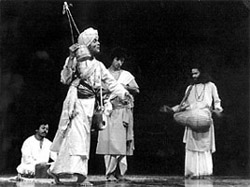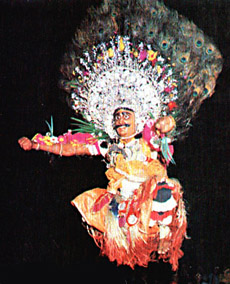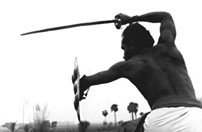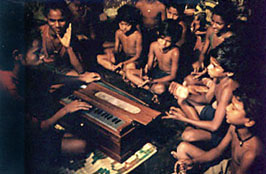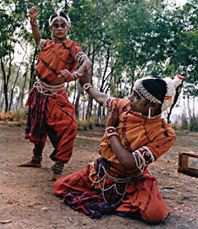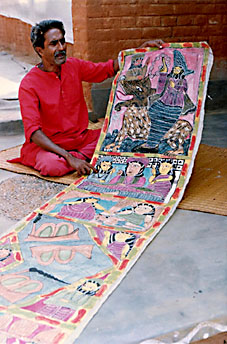|
|
Bauls
of Bengal
|
|
|
Bauls
originate from a community of wandering mystical singers that goes
back to the Middle Ages. Even if they are Hindus, they do not recognize
caste divisions, they profess equality of faiths and religions and
retain that Divinity has its place in the Heart of every Man.
Bauls were re-discovered by Rabindranath Tagore, a renowned
Indian poet. Tagore regarded Bauls’ poems as masterpieces of
Indian literature. Performing arts and creative techniques have
become for Bauls a way of living that was originally combined
with the search for inner knowledge. Nowadays it is the artistic
aspect that prevails, to the detriment of personal search.
Bauls make their own characteristic musical instruments and
are true masters of improvisation. They live through their music.
The joy of being alive and present that comes from it is what makes
them become true Bauls, i.e. “God’s fools”.
|
|
|
|
That is why, brother,
I have become a crazy Baul.
I do not obey any master or order.
Man-made distinctions don’t affect me.
I dwell in the joy of love that springs forth from my being.
Love knows no separation, but only the meeting of hearts forever.
And so I find joy in singing and dancing with one and all.
That is why, brother, I have become a crazy Baul.
|

Chhau
|
|
Chhau
is an ancient sacred dance of Purullia (Bihar). To this day tribal
rural populations are practicing it while invoking Shiva to grant
them rain and abundant harvest.
Chhau dancers use beautiful masks (weighing up to 4 kilos)
that represent Hindu deities, demons and tribal spirits. Each mask
has only four tiny perforations that let through a very limited amount
of air and light.
Two big drums: one-membrane Nagra and two-membrane Dhal
mark the pace and the rhythm of the dance while the drama itself is
introduced by a pipe (Shanai) tune. All the stories come from the ancient sacred books of India: Mahabharattha,
Ramayana and Purana.
An explosion of energy and movement, daredevil somersaults and jumps
are distinguished traits of the Chhau dance. |
|

Kalaripayatthu
|
|
|
|
Kalaripayatthu
is one of the most ancient martial arts of India. It originates
from Kerala and is sometimes called the Mother of all artistic disciplines
of Southern India. It’s considered to be a Dravidian art, i.e.
belonging to the native Southern Indian tradition.
Its practice is always preceded by Guruvandhanam i.e. salutation
of Heaven, Earth, one’s own Guru and the god Ganesha. The series
of movements (the first is always a defense) covers four cardinal
directions and involves one’s whole body.
Sticks, one- and multi-blade knives, swords, shields and fire are
used in this traditional combat.
|
|
Throughout
the ages, together with the practice of martial techniques, the
Marma: knowledge of a human body and its 108 energy and vital
centers, has been developed.
Two young Kalaripayatthu masters that work with us come from
a renowned Trivandrum school.
|
|

Gotipua
dance from Orissa
|
|
|
|
The roots of the Gotipua
dance go back to Indian Middle Ages and are linked to the ancient
tradition of Devadasi (temple dancers).
The soft harmony of acrobatic movements combined with vocal and
instrumental accompaniment (Paknaj percussions and Harmonium keyboards)
characterize this traditional dance.
|
|
Gotipua celebrates
the reunion of Man with Divinity in which the worshiper becomes
identified with the female element (Shakibhava).
Dancers are boys between the age of 8 and 15 dressed in woman’s
clothes.
The Gotipua
dance has some common traits with the Odissi dance, but the techniques
of movement and the themes are very different from it.
Using a very refined in style, Gotipua dancers perform precise
steps, as well as Mudra (hand gestures), eye and facial expression
and Classic Yoga postures.
|
|

Patuas
|
|
The Patuas (from
a Bengali word pata: leaf) are traditional painters and storytellers.
On long scrolls of cloth or paper they draw ancient stories from Hindu
and Muslim scriptures, they depict tribal legends and paint images
describing current events.
As they show the painted scrolls to their audience they sing a corresponding
story. Many songs have been orally transmitted.
Paintings are done with natural colors, using clay, ash, roots and
plants.
The Patuas, in spite of the fact that they are traditionally
recognized as descendents of the divine craftsman Viswakarma, are
put outside of the caste system. That is why throughout the ages;
many have converted to Islam hoping for a life of social equality,
yet holding on to their Hindu roots.
Today Patuas observe both, Hindu and Muslim, festivities.
For a long time they have represented a unique link between urban
and remote rural areas where they meet and incorporate traditions
of local tribal populations. |
|

Fakirs
|
|
|
|
Fakirs
belong to the Muslim community of India. Their roots go back to the
Sufi tradition.
Nowadays Fakirs and Bauls can be found only in West
Bengal and in Bangladesh. Their unique trait is the fact that Fakirs
who are Muslims and Bauls who are Hindus have the same masters, participate
in the same festivities and many Fakirs spend long periods
of time at the holy Hindu sites. However, Fakirs’ songs
are quite distinct from Bauls’ songs and usually follow
repetitive patterns. Fakirs use small drums and simple string
instruments. |

|


